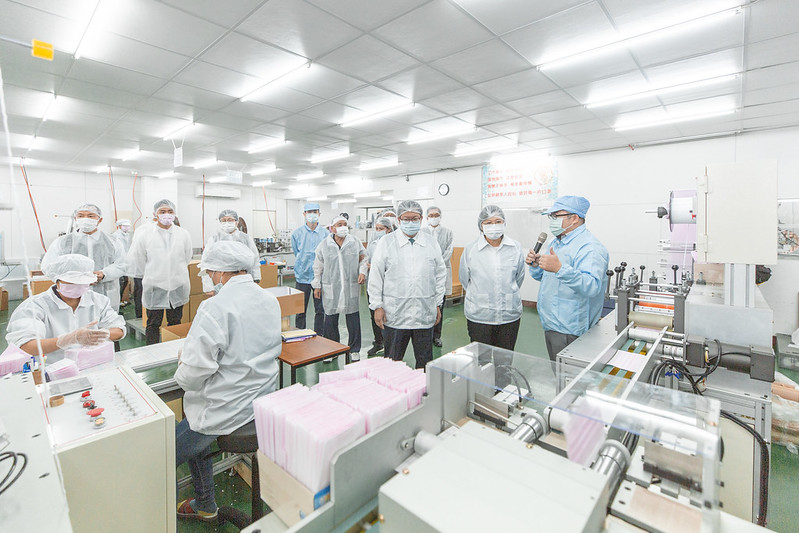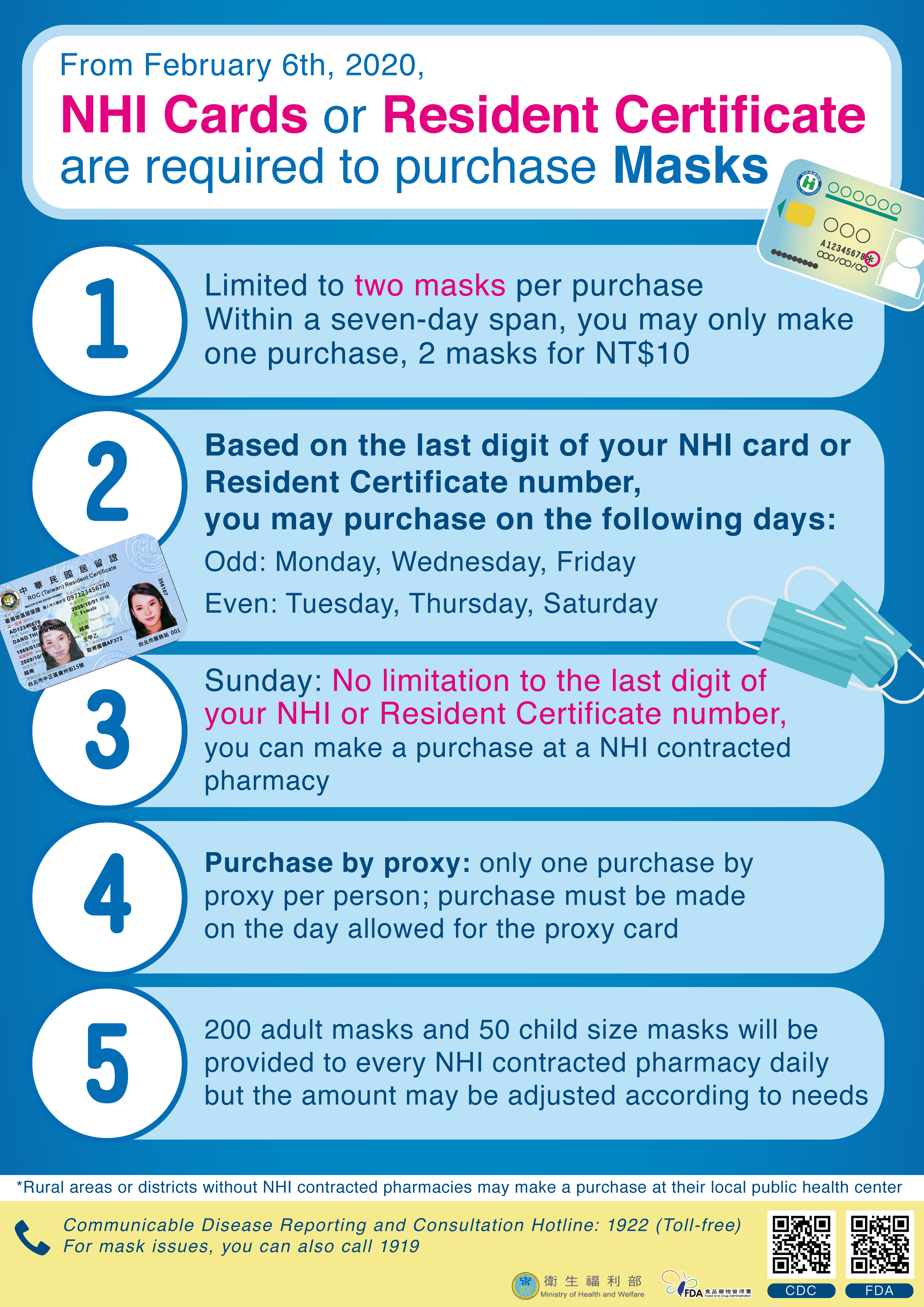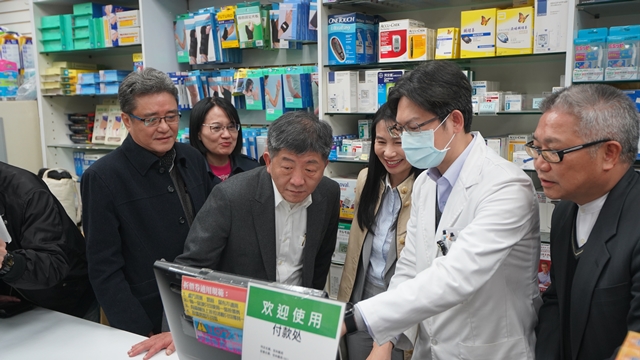Provide a steady supply of disease prevention supplies to reassure society and the people
I. Medical supplies for epidemic prevention:
Background
As the COVID-19 epidemic became more serious globally, the international supply of epidemic prevention supplies became more restricted. In the past, supplies such as N95 respirators, protective apparels, and isolation gowns in Taiwan were mostly dependent on imports, and manufacturers stopped production during the Spring Festival, thus causing supply shortage. In response, a control policy on related medical countermeasures for epidemic prevention was implemented.
Implemented Measures
I. “3-tier Safety Stockpiling Framework of Personal Protective Equipment” was put in place to fulfill the basic requirements for personal protective equipment during disease prevention for health care and public health systems; related important epidemic prevention supplies are allocated on the basis of medical personnel, epidemic prevention and disadvantaged groups first.
II. Increase production or make emergency procurements to maintain steady supplies: The Ministry of Economic Affairs coordinated with manufacturers to increase production, and consolidated domestic enterprises including raw material suppliers and manufacturers to assist in producing disease prevention supplies.
III. From February 16, 2020, N95 respirators produced by domestic manufacturers were expropriated; protective apparels and isolation gowns were purchased for emergency, and allocated on the basis of medical personnel, epidemic prevention and disadvantaged groups first, so as to provide for the medical personnel at the front line, epidemic prevention personnel and the general public.
IV. By using the Epidemic Prevention Supplies Management Information System, information such as purchases, stocking, inventory, collection and re-stocking at all levels of inventory units can be monitored in real time. Furthermore, they can be delivered to local health bureaus and hospitals in a regular cycle, based on the inventory conditions at the local health bureau and hospitals.
V. The command center coordinated and consolidated related medical countermeasures for epidemic prevention (such as: forehead thermometers, masks, respirators, isolation gowns and medicinal alcohol), and healthcare institutions providing medical care were given priority for these supplies. From February 2020, communications with the medical industry and all business management units were kept, in order to manage, respond to, and solve problems in a timely manner. The disease prevention supplies from healthcare institutions were organized and shown in the following table:
| Category | Item | Distribution Rules | Note |
|---|---|---|---|
| Mask | Surgical Mask | Local county/city health department distributes 1,700,000 surgical masks, 70% for its local healthcare institutions and 80 masks/week per physician. | |
| Mask | N95 Mask | Distribution on an irregular basis, 3 masks/week per western medicine/traditional Chinese medicine/dental clinic; 6 masks/week per dental/otolaryngology/pediatric clinic. | MIS safety stock 115% for the regular hospitals |
| IsolationGown | Distribution on an irregular basis, 3 gowns/week per western medicine/ traditional Chinese medicine/dental clinic. | MIS safety stock 133% for the acute care hospitals and testing facilities |
(Mask and Other Epidemic Prevention Supplies)
II. Related control measures regarding masks:
Background
Since the main transmission pathway of the novel coronavirus is via contact with virus-carrying secretions or droplets, a mask is one of the most crucial items for implementing personal protection. To guarantee a sufficient supply of masks for our people, we expropriated, in a lawful manner, general medical masks and surgical masks produced by domestic factories, restricted exports of masks, and sped up the establishment of mask production lines. In addition, to ensure that all citizens would have a fair chance to buy masks, we have also introduced the Name-based Mask Distribution System.
Implemented Measures
I. From January 24, 2020, exports of masks were temporarily suspended.
II. Epidemic prevention supplies were deployed in advance, and a national mask team was created: General medical masks and surgical masks produced domestically were expropriated, and deployment of 60 mask production lines was completed, which enabled our daily mask production to be increased from 1.88 million to 19 million as of the end of April 2020.
III. From February 6, 2020, the “Name-based Mask Distribution System 1.0” was put in place (physical channel):
- Citizens could take their NHI cards and foreigners could take their resident permits or entry and exit permits, and go to designated NHI-contracted pharmacies to purchase a quantity of masks as regulated by the Command Center; queues were divided according to odd/even numbers for the last digit of the individual's National ID Number (from April 9th, the diversion restriction has been cancelled).
- The National Health Insurance Administration of the Ministry of Health and Welfare created a “Disease Prevention Mask Control System” in the “NHI VPN system”, in order to enable the NHI-contracted pharmacies to register stocking and purchasing information, and facilitate sales management.
- Apart from the masks for civilian use mentioned above, the Command Center allocated disease prevention masks for medical and official businesses, and delivered the masks to hospitals, health bureaus and medical and nursery institutions and units, as well as all official business units that had a requirement for disease prevention.
- For those who were unable to purchase masks on their own, including elderly people who lived alone, physically and mentally disabled persons and special patients, masks were also delivered to local governments, medical institutions and related units, so that the above-mentioned people could acquire masks easily.
- With respect to the requirement for masks in industries, the Ministry of Economic Affairs was responsible for consolidating and allocating.
- Due to the slowdown of the COVID-19 epidemic situation, the demand for people to buy masks has decreased. In order to facilitate the distribution of masks, from November 15, 2021, the pharmacies/health bureaus can make their own demand of number and type of mask according to the " Disease Prevention Mask Control System ".
- As of April 30, 2022, there were about 3,452 pharmacies participating the Name-Based Mask Distribution System 1.0.
- Due to the masks are plentiful and convenient to buy, from May 1, 2022, the number of the pharmacies has been adjusted to 144 and until their the Name-based Mask Distribution would be sold out for the last delivery on April 1, 2022.
IV. From February 16, 2020, all sales locations of the Name-based Mask Distribution System were integrated into the 303 health bureaus in Taiwan; from February 27, 2020, a total of 340 health bureaus (including health service centers) and health offices started to participate in sales. As of November 29, 2021, due to the increasing number of community screening stations and vaccinations, the Epidemic Command Center agreed to reduce the health bureaus (including health service centers and health offices) from 340 to 71 and no more participate in sales from May 1, 2022.
V. On March 12, 2020, the “Name-based Mask Distribution System 2.0” (online channel) was introduced (ceased on October 24, 2021):People can go online to buy masks with NHI Health Express APP on a cellphone, or go to eMask purchase system with the NHI card/ Citizen Digital Card and a computer to buy masks anytime and anywhere.
VI. On April 22, 2020, the “Name-based Mask Distribution System 3.0” (pre-purchasing at convenience stores) was introduced (ceased on October 24, 2021):In order to provide people with a more convenient way to pre-order masks, people can make an order on Kiosk with their NHI Card at the convenient stores nationwide.
VII. The Command Center adjusted the mask purchase cycle and restrictions on purchasable quantity for each person according to national mask production and epidemic conditions.
VIII. To strengthen the quality management of imported medical masks, TFDA has implemented border examination since July 7, 2020. At the end of March 2023, 155 batches of imported medical masks have been inspected. 14 of them were not allowed to be imported. This strategy prevents masks with poor quality from entering the domestic market.

(President Tsai, Ing-Wen visited the National Mask Production Team)
(Commander Chen, Shih-Chung and TFDA Director General Wu, Shou-Mei visited local pharmacies in preparation for the Name-based Mask Distribution System)

(From Feb. 6th, 2020, NHI cards or Resident Certificate are required to purchase Masks.)

(Here's the bottom line: Face mask are sold in packages.)

(The right way to wear a mask)
III.The Food Service Implement Epidemic Prevention and Strictly Protect the Community Defense Line:
Background
In order to ensure the health of catering employees and the public people, Notice and Guidelines are announced to avoid COVID-19 cluster infection and the spread of the epidemic.
Implemented Measures
The Ministry of Health and Welfare has announced the “Notice of COVID-19 Prevention and Management for the Food Service” on July16, 2021. Food Service operators must comply with both this Notice and the "Severe Special Infectious Pneumonia (COVID-19) Epidemic Prevention Measures Penalty Regulations" to provide meals in restaurants.
The Ministry of Health and Welfare also provides the "Guidelines for Epidemic Prevention in the Food Service". Food Service operators can refer to the Guidelines to internalize the necessary epidemic prevention management suitable for individual venues according to actual feasibility and applicability, so as to reduce the probability and scale of the epidemic in dining place.
The "Notice of the COVID-19 control and management measures for the Food Service” are adjusted on a rolling basis in accordance with the epidemic prevention regulations of the COVID-19 Central Epidemic Command Center. In order to cooperate with the relaxation of epidemic prevention policies, the Ministry of Health and Welfare has discarded "Notice of COVID-19 Prevention and Management for the Food Service" and abated the "Guidelines for Epidemic Prevention in the Food Service" on March 27, 2023. The Food Service are notified through the bulletin board of the Food and Drug Registration Platform information system and emails.
IV. COVID-19 Surveillance Report on Imported Cold Chain Food Packaging:
Background
Since the outbreak of the epidemic in China, the new coronavirus (SARS-CoV-2) was found on the cutting board that had been once cut the imported salmon in the seafood market. Although salmon was later being ruled out as the source of SARS-CoV-2 transmission, Chinese media continued to report the SARS-CoV-2 nucleic acid testing positive on the outer packaging of the imported Ecuador frozen white shrimp, Brazilian frozen chicken wings and pork, and Indian frozen pomfret and cuttlefish. Even ice pop and cherries had also been announced SAR-CoV-2 nucleic acid testing positive. The above-mentioned reports have aroused great attention and concern among the public in Taiwan.
Implemented Measures
The decision made by the Central Epidemic Command Center (CECC) instructed the TFDA to "conduct a pilot study on the feasibility of monitoring and cost-benefit analyzing of the imported frozen food from high-risk countries". This study has been included to the CECC five enhanced monitoring surveillance programs for COVID-19 since August 23, 2021. On October 5, 2021, the CECC further announced that the "Enhanced Testing Plan for Imported Frozen Foods" was implemented as the regular monitoring program. Since then, TFDA has processed the inspection of the imported food. From November 6, 2020 to August 31, 2022, totally 350 batches of products and 1,356 samples imported to Taiwan from 33 countries have been sampled, and the nucleic acid test results of the COVID-19 virus were all negative.
V. Proactively Reducing Tariffs for Raw Materials of Medicinal Alcohol:
Background
Since the epidemic began in China, Taiwan's society has placed a greater emphasis on personal hygiene and protection, and the demand for disinfection and disease prevention by the people and enterprises increased by the day. To avoid a shortage of raw materials for medicinal alcohols, we have lowered tariffs for related items to encourage importation by industries.
Implemented Measures
The Customs Administration of the Ministry of Finance reported to the Executive Yuan that the tariff for raw materials of medicinal alcohols would be reduced from 20% to 10% from February 27, 2020 to August 26, 2021.
VI. Control on Exports of Medicinal Alcohols and Hand Sanitizers that have Drug Permit Licenses:
Background
With the development of the epidemic, the international demand for medicinal alcohols and hygiene hand gel has grown stronger, therefore controls on exports of related products were put in place to guarantee that the domestic medicinal alcohols and hygiene hand gel could satisfy domestic demand.
Implemented Measures
Controls on exports were put in place and will be continued from April 16, 2020 until the Command Center is disbanded; during the period of control, if a manufacturer holding a drug permit license for medicinal alcohols and hygiene hand gel intends to export, the manufacturer should submit application letters to the FDA for prior approval each time.
VII. Comprehensive Taiwan Drug Supply Database Platform:
Background
The supply shortage of medicines is an important and current public health issue that the world must collectively face; ever since the epidemic outbreak, news related to the shortages of medicines have often caused panic in societies. In light of the gravity of the medicine supply and shortage issue, the FDA established the “Taiwan Drug Supply Database Platform” and keeps it updated, so as to effectively prevent medicine shortages and ease the impacts of insufficient medicine supplies, and guarantee the rights to medicines for the people.
Implemented Measures
I. The FDA has set up the “Taiwan Drug Supply Database Platform” and the corresponding strategic plans for drug shortages; When the platform receives the drug shortage report, the pharmacists are assigned to initially review the report, further evaluate possible drug substitutes and post the results of the drug evaluation on the platform.
II. From the outbreak of COVID-19 to the disbandment of the Command Center. To reduce the risks of supply disruptions or drug shortages, the FDA has announced two guidelines, the “Medicine Supply Management Principle during the Disease Prevention Period regarding Severe Special Contagious Pneumonia” and the “Handling Guide for Unequal Allocation of Medicines during the Disease Prevention Period regarding Severe Special Contagious Pneumonia, to prevent uneven distribution or stockpiling of drugs in medical institutions or pharmacies.
Related Link
- Created:2023-04-14
- Last Updated:2023-05-12
- Data Source:Food and Drug Administration, Ministry of Health and Welfare
- Count Views:

